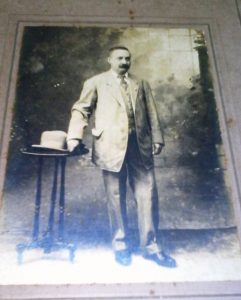Throughout the ages, people keep wealth, memories of different kinds, and documents, but I have never seen such a unique treasure. I found it in the José Martí neighborhood, at the end of Chino Manuel Street.
The owner is Noris Montero Miranda, a sweet grandmother, who wants to share this secret kept in her family, almost a century ago. Since February 27, 1921, her grandfather collected this “Holy Relic of the Nation” and with the signature of several eyewitnesses and the stamp of the mayor’s office, he put it in a box of cigars for his children and grandchildren.
Grandpa
 Don Agustín de Miranda y Piloña was colonel of the Liberation Army, he witnessed the birth of the Constitution of Guaimaro and everything related to the homeland was always a priority for him.
Don Agustín de Miranda y Piloña was colonel of the Liberation Army, he witnessed the birth of the Constitution of Guaimaro and everything related to the homeland was always a priority for him.
Thus, as time went by and the house where the Constituent Assembly took place on April 10, 1869, Agustín, in front of the demolition of the building, with some of his compatriots, picked up a brick from those walls, where the words of justice and freedom rumbled.
In a sort of historical testament, he wrote down the details of the object and the importance of preserving it for his children.
He gathered the rubrics of: Federico Varona, Captain of the Liberator Army and of the eyewitnesses of the Constitution of Guáimaro, Ezequiel Ávila and Pedro Hernández. He appended a machine-made copy of the 29 paragraphs of the First Constitution of the Republic in Arms to the authentication document. This First Constitution was an expression of the will of the Cuban independence movement, and the political organization that gave the liberators of 1868.
On April 12, the Assembly was completed and Carlos Manuel de Céspedes was appointed as President of the Republic of Cuba in Arms, Salvador Cisneros Betancourt as President of the House of Representatives and Ignacio Agramonte as Secretary of War.
The Constitution of Guáimaro also left as positive balance for the Homeland, the selection of the flag of the lonely star, that is, the one designed in 1849 by Miguel Teurbe Tolón as the official flag of Cuba, while the flag raised by Céspedes in The Demajagua was placed in the sessions of the House of Representatives and conserved as part of the National Treasury. The official hymn was the hymn composed in Bayamo by Perucho Figueredo on October 20, 1868. Both stayed forever as symbols of our identity.
Who saved the treasure
 The daughter of Don Agustín de Miranda, Eva, was in charge of keeping the relic and talking about it to her heirs. His 108 years old did not allow him to dialogue, that’s why his daughter Noris is the one who, fulfilling the family will, sought us to share this beautiful story.
The daughter of Don Agustín de Miranda, Eva, was in charge of keeping the relic and talking about it to her heirs. His 108 years old did not allow him to dialogue, that’s why his daughter Noris is the one who, fulfilling the family will, sought us to share this beautiful story.
His grandson, Jorge Mario Palenzuela was trained in the Trade School of the Office of the Historian and his sensitivity for the heritage brought him to our door as a guide for an adventure to the past. In this way and accompanied by my colleague María del Carmen Pontón, who enjoys such findings as much as I do, we walk to the peaceful dwelling where, with zeal and pride, the unusual treasure is kept.
There are a few days until the new Cuban constitution comes into force and next April 10 will be 150 years of the first written by Ignacio Agramonte in Camaguey lands. It seems that the historical connotation of the ephemeris conspired to discover this material connection. When I took the fragment of brick in my hands, I felt myself returning in time and receiving permission to tell them about this experience.
In my trip to the rebellious Guaimaro of 1869 I met the strength of several Cuban patriots, I heard Ana Betancourt demanding rights for women, which I am proud of as Cuban, and finally …
I was moved by the patriotic pride of Colonel Agustín, a straight man of high honor, who so carefully kept the fragment of brick and bequeathed it to his children and grandchildren, thanks to his vision of the future today we find it as a palpable trace of that historic Assembly.
Photos: Jesmir Varona Socías
Translated into English by Yisel Torres Ruiz






